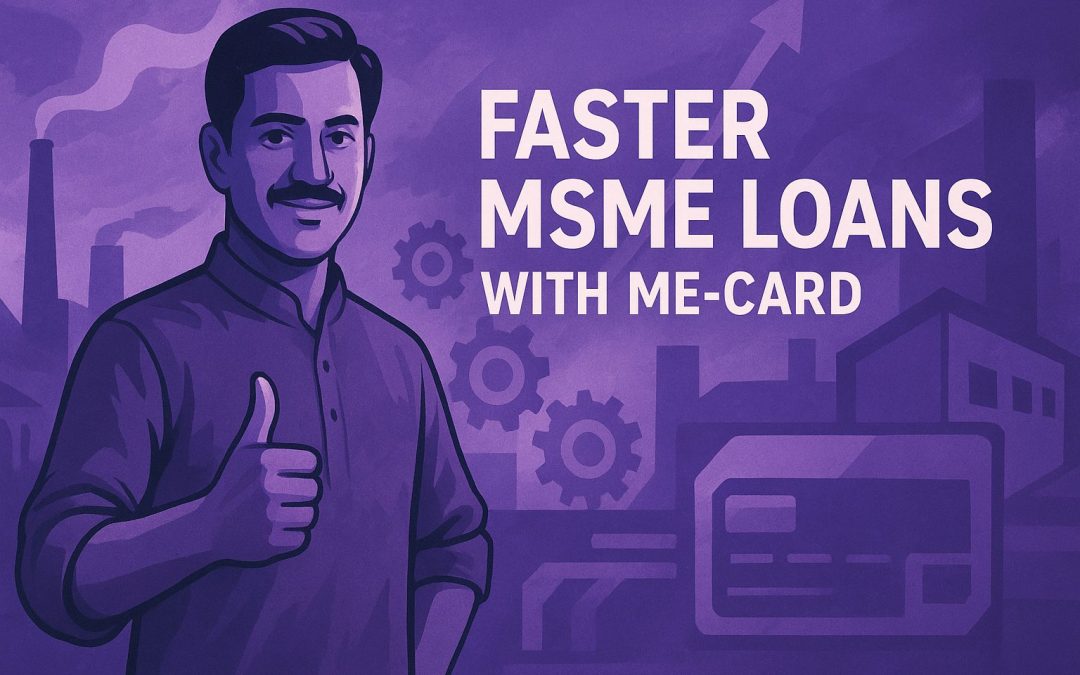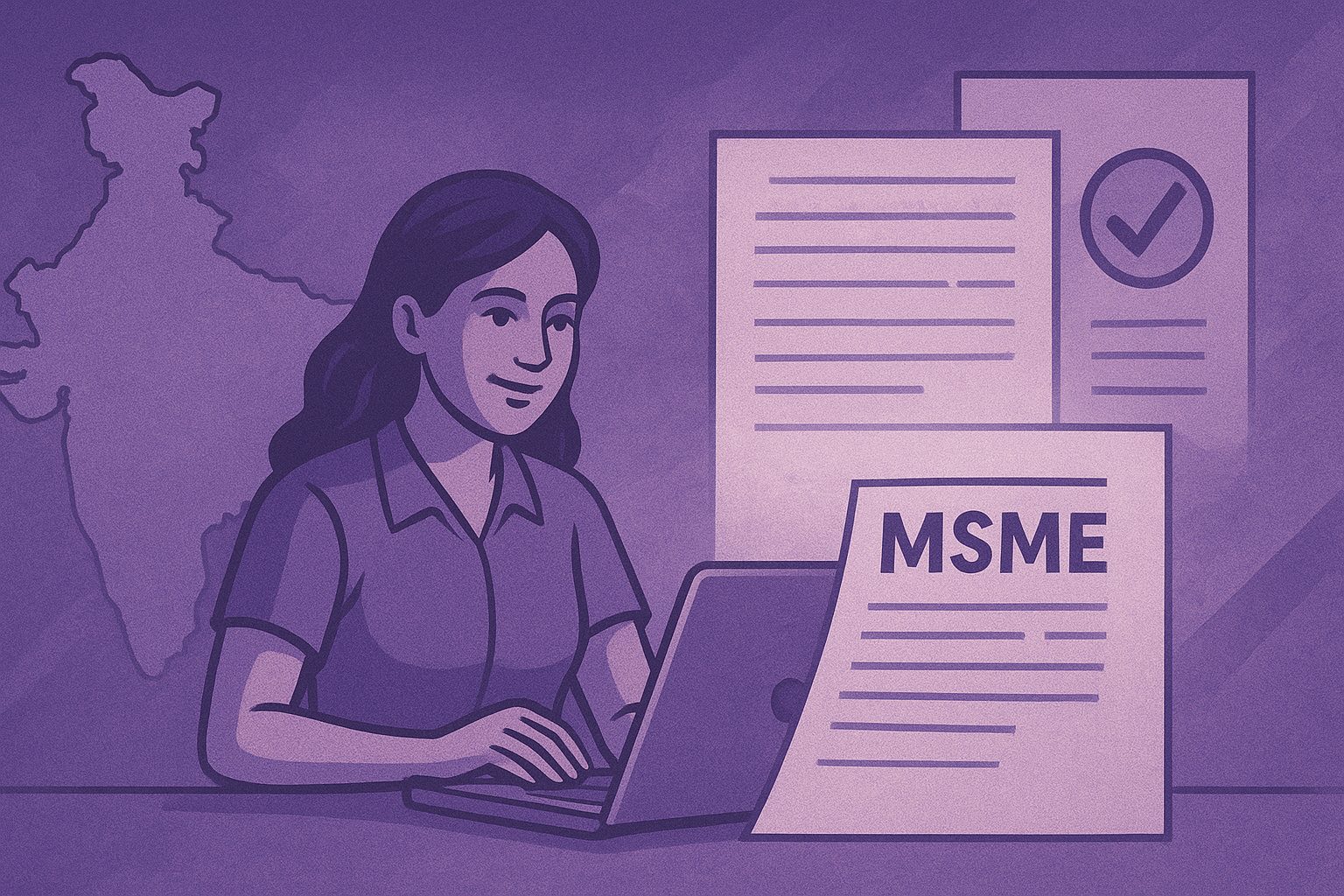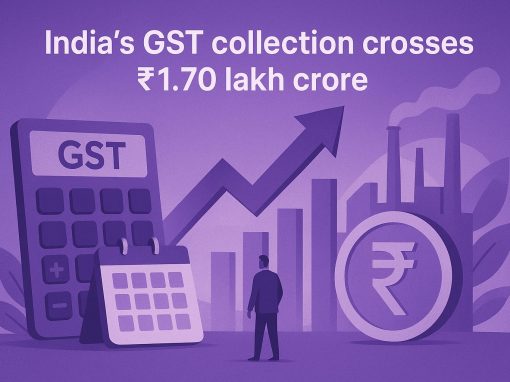Table of Contents
The Government of India has launched a renewed policy drive to improve credit access for micro, small and medium enterprises (MSMEs). As part of this initiative, banks have been directed to double the issuance of Micro Enterprise Cards (ME-Cards) to accelerate lending to micro-businesses.
Each card offers a credit limit of up to ₹5 lakh, providing much-needed working capital support for small entrepreneurs. The process is being made fully digital, enabling quicker approvals and transparent monitoring through verified enterprise data. This move aims to simplify MSME financing, strengthen liquidity in the sector, and stimulate growth at the grassroots level of India’s economy.
The ME-Card gives a credit limit, backed by government guarantee cover, to support micro-businesses in bridging cashflow gaps and participating in procurement and credit markets.
Eligibility (Udyam-registered MSMEs)
To be eligible for the ME-Card, an enterprise must be registered on the Udyam Registration Portal under the category of “micro” as defined by the Ministry of Micro, Small & Medium Enterprises.
The current definition for a “micro” enterprise is: investment in plant & machinery or equipment not exceeding ₹2.5 crore and annual turnover not exceeding ₹10 crore. The scheme is specifically meant for micro units, not for the small or medium enterprise categories.
Key Features
-
Credit Limit: Each ME-Card will carry a limit of up to ₹5 lakh for eligible enterprises.
-
Revolving Credit Nature: The card acts like a revolving credit facility — the enterprise can draw, repay and redraw up to the credit limit (subject to terms) as needed. This provides flexibility to manage working capital. (Understanding revolving credit: you borrow up to a limit, repay, and borrow again as long as the account remains open).
-
Validity and Renewal Conditions: While the detailed scheme guidelines are still evolving, the ME-Card is issued in the context of ongoing support for micro-enterprises and is expected to be renewable based on continuing eligibility (registration, turnover/investment criteria, good repayment track record).
-
Credit Guarantee Cover: To make lending affordable and less risky for banks, the guarantee cover for micro & small enterprises has been increased (from ₹5 crore to ₹10 crore) and this support aligns with the ME-Card rollout.
-
Digital & Simplified Process: The issuance and servicing of the ME-Card are intended to be co-ordinated with digital platforms (Udyam registration data, credit information, etc.) to reduce documentation and speed up approvals.
In essence, the ME-Card is a targeted instrument to empower micro enterprises by offering them a simplified, credit-card-style financing facility (up to ₹5 lakh) that they can use repeatedly, subject to eligibility and proper management. The scheme strengthens formal registration (via Udyam), links to government guarantee frameworks, and aims to improve financial inclusion and agility of the micro business sector.
Overview of ME-Card Initiative
The government has instructed banks to sharply increase the issuance of the ME-Card to micro-enterprises this year. Previously the goal was to issue 1 million cards, but under the new directive the target has been raised significantly to as many as 20 million cards.
With each card offering up to ₹5 lakh in credit, the total additional lending to the MSME sector is projected at ₹25,000–₹30,000 crore. The push is framed as part of a broader drive to improve working capital access for formally registered micro businesses.
Policy Goals of ME-Card
The directive reflects several underlying policy goals:
-
To bridge the financing gap faced by micro units, especially those registered under the Udyam Portal, by providing a simplified credit instrument.
-
To promote formalisation of micro-enterprises by linking eligibility to formal registration (Udyam) and thus bring more units into the formal credit system.
-
To fast-track digital lending by leveraging digital data, bank statements and the account-aggregator ecosystem rather than heavy paperwork or collateral.
-
To boost economic participation and employment at the grassroots by making smaller units more resilient via easier access to working capital.
-
To enhance financial inclusion, by ensuring micro-enterprises in less-served regions or with limited collateral can access credit on easier terms.
Expected Outcomes & Significance
If implemented as planned, the scheme’s expansion could lead to:
-
A major expansion of credit outreach into the microbusiness sector; millions more units getting a dedicated credit facility.
-
A notable injection of liquidity into micro-enterprise operations, aiding inventory purchase, raw materials, utility payments, and general working capital.
-
Strengthened credit discipline and formal credit history among micro‐units, which may improve their future borrowing capability.
-
A structural shift in MSME finance: simpler, faster, digital-first credit processes replacing more cumbersome traditional bank loans.
Key Considerations & Challenges
-
Achieving the scale (20 million cards) will require banks to streamline processes, manage risk, and scale digital‐onboarding effectively.
-
Ensuring the credit quality remains intact, especially given the simpler assessment models and large volume, will be important.
-
Monitoring renewal and usage of cards to avoid misuse and ensure working capital is used for enterprise operations and not diverted.
-
Ensuring that micro units, including those in remote or underserved areas, are aware of and able to access this facility.
In summary, the directive to nearly twenty-fold the ME-Card rollout, from 1 million to up to 20 million cards, alongside an estimated ₹25,000–₹30,000 crore of additional lending marks a bold push by the government to broaden micro-enterprise credit access and deepen financial inclusion.
Background: Why MSMEs Need Easier Credit
-
Backbone of the Economy:
MSMEs contribute nearly 30% of India’s GDP, employ over 11 crore people, and account for 45% of exports, making them vital to inclusive growth. -
Persistent Credit Gap:
Despite their importance, micro and small enterprises face a credit gap of over ₹20 lakh crore, as many remain outside the formal lending network. -
Barriers to Formal Finance:
Common hurdles include limited collateral, lengthy loan approvals, inconsistent income records, and low digital or financial literacy, especially among micro-units. -
Dependence on Informal Sources:
Many micro-enterprises rely on high-interest informal credit, restricting their ability to expand operations or invest in productivity. -
ME-Card as a Solution:
The ME-Card introduces a simplified, collateral-free credit tool for Udyam-registered micro businesses. -
Digital and Inclusive Approach:
It enables faster, paper-free approvals using verified enterprise data, helping formalise credit access for small entrepreneurs across India. -
Goal:
To make credit affordable, accessible, and recurring, thereby bridging the financial inclusion gap and supporting sustainable MSME growth.
ME-Card Implementation Checklist
1. Application Stage
-
Enable online application via bank portal, MSME app, or Udyam-linked site.
-
Capture Udyam Registration Number, Aadhaar, PAN, and business details.
-
Obtain borrower consent for digital data sharing (via Account Aggregator).
2. Digital Verification
-
Perform instant e-KYC through Aadhaar or bank-verified KYC APIs.
-
Validate enterprise registration and ownership using Udyam data.
-
Auto-check GSTIN or PAN for active business status.
3. Credit Assessment
-
Fetch financial data from multiple digital sources:
-
UPI transaction patterns (sales and receipts).
-
Bank statements (cash flow consistency).
-
Account Aggregator data (tax returns, invoices, utility bills).
-
-
Feed all inputs into the credit decision engine for automated scoring.
4. Loan Sanctioning
-
Determine eligible credit limit (up to ₹5 lakh) and tenure.
-
Generate and display digital offer letter with transparent terms.
-
Capture e-signature for agreement confirmation.
5. Disbursal Process
-
Link ME-Card to borrower’s current account or issue a virtual card.
-
Credit approved amount instantly as a revolving facility.
-
Notify borrower via SMS/app and dashboard confirmation.
6. Usage and Monitoring
-
Allow flexible draw, repay, and redraw within sanctioned limit.
-
Auto-generate digital statements and repayment reminders.
-
Track account behaviour in real time using API data and alerts.
7. Repayment & Collections
-
Enable auto-debit or manual repayment through UPI or net banking.
-
Apply dynamic interest based on utilisation and repayment history.
-
Send proactive reminders before due dates; manage delinquencies digitally.
8. Renewal & Limit Review
-
Automate annual renewal based on repayment record and updated data.
-
Offer limit enhancement for consistent payers.
-
Restrict or suspend limit for high-risk or inactive accounts.
9. Risk Management & Compliance
-
Implement consent-based data pulls through the AA framework.
-
Encrypt all customer data; maintain full audit trail of access and actions.
-
Periodically review model accuracy and ensure compliance with RBI norms.
10. Customer Support & Inclusion
-
Provide multilingual help through chatbot, IVR, and local branches.
-
Conduct outreach for digitally unserved micro-units.
-
Maintain an escalation path for grievances and quick redressal.
Bank Readiness and Implementation Steps
| Component | Details and Actions Required |
|---|---|
| Common Eligibility Criteria | – Udyam-registered micro-enterprises only. – Business must have an active current account with the issuing bank or a partner bank. – Satisfactory credit history or first-time borrower under government guarantee cover. – Valid Aadhaar, PAN, and GSTIN (if applicable). |
| Standardised Application Form | – Short, single-page digital form capturing Udyam number, enterprise type, contact details, and consent for data sharing. – Integration with Account Aggregator and KYC systems for automated verification. – Uniform template advised by the Finance Ministry to maintain consistency across banks. |
| Role of Public Sector Banks (PSBs) | – Lead rollout and target achievement under government directives. – Extend ME-Cards through existing MSME and Mudra desks. – Coordinate closely with SIDBI for guarantee cover and data reporting. – Prioritise outreach in semi-urban and rural areas to expand inclusion. |
| Role of Private Sector Banks | – Support expansion through digital platforms and fintech partnerships. – Use advanced credit analytics and faster onboarding tools. – Focus on technology-driven risk assessment and customer experience. – Collaborate in sharing best practices and process innovation. |
| Coordination with SIDBI | – SIDBI to act as the nodal agency for risk-sharing, monitoring, and data consolidation. – Manage guarantee cover under the Credit Guarantee Fund Trust for Micro and Small Enterprises (CGTMSE). – Collect and analyse lending data for policy feedback to the Finance Ministry. |
| Coordination with the Finance Ministry | – The Finance Ministry oversees rollout targets, policy alignment, and financial inclusion metrics. – Issues operational guidelines, ensures budgetary support for guarantee cover, and monitors bank performance. – Conducts quarterly reviews with SIDBI and banks to assess progress and resolve implementation challenges. |
| Capacity and Infrastructure Readiness | – Banks to ensure digital infrastructure, staff training, and data security compliance. – Integration with Udyam portal, AA ecosystem, and UPI rails for smooth processing. – Establish dedicated helpdesks for MSME customers during rollout. |
Benefits of ME-Card for MSMES
-
Faster Disbursal:
The ME-Card ensures quick loan approvals and instant access to funds through a fully digital process. -
Simplified Access:
Minimal paperwork and automated verification make it easier for micro-enterprises to apply and qualify for credit. -
Collateral-free Working Capital:
MSMEs can access up to ₹5 lakh without pledging assets, easing liquidity pressure and supporting day-to-day operations. -
Credit History Development:
Regular repayments help build formal credit records, improving future borrowing potential and eligibility for larger loans. -
Better Cashflow Management:
The revolving credit feature allows flexible borrowing and repayment cycles aligned with business needs. -
Broader Economic Impact:
Wider credit access boosts MSME productivity, job creation, and regional economic growth, strengthening India’s overall financial inclusion and GDP contribution.
Challenges and Safeguards
-
Data Privacy and Cybersecurity: Ensuring secure handling of financial and personal data is critical as the ME-Card relies on digital verification and data sharing through the Account Aggregator system. Banks must implement strong encryption, consent-based access, and regular security audits to prevent breaches.
-
Over Borrowing and Misuse Risks: Easy access to revolving credit may lead some enterprises to overextend or use funds for non-business purposes. Lenders need to apply prudent credit limits, monitor utilisation patterns, and provide financial counselling where needed.
-
Awareness and Digital Literacy: Many micro-business owners still lack familiarity with online lending tools. Targeted training, multilingual support, and local outreach programmes are essential to help them use the ME-Card safely and effectively.
-
Safeguard Mechanisms: A joint oversight framework involving banks, SIDBI, and the Finance Ministry should monitor implementation, detect early signs of misuse, and promote responsible borrowing practices across the MSME ecosystem.
Broader Economic Impact
The expansion of the ME-Card programme is expected to generate a ripple effect across India’s economy. By improving access to affordable, collateral-free working capital, it can strengthen productivity among millions of micro and small enterprises. This, in turn, is likely to boost GDP growth, expand employment opportunities, and support export competitiveness, especially in labour-intensive sectors such as textiles, handicrafts, and food processing. The initiative also holds strong potential to revitalise the rural economy, enabling small traders, manufacturers, and service providers in smaller towns and villages to scale up operations with timely credit.
Aligned with the government’s Digital India and Make in India missions, the ME-Card reinforces a shift toward technology-led, inclusive growth. Its end-to-end digital process not only reduces friction in credit delivery but also brings previously unbanked micro-units into the formal financial system. The integration of UPI, Aadhaar-based KYC, and the Account Aggregator framework demonstrates India’s growing capability to link financial inclusion with digital innovation.
Conclusion
The ME-Card marks a significant step toward transforming micro-enterprise financing in India. By combining digital infrastructure, simplified credit processes, and targeted policy support, it addresses long-standing barriers that have kept many micro businesses outside formal credit access. In the long run, this initiative can deepen financial inclusion, promote entrepreneurship, and enhance the resilience of India’s MSME sector. If implemented effectively, the ME-Card could become a cornerstone of a more inclusive, digital, and self-reliant credit ecosystem, driving sustainable economic growth from the ground up.
Empowering MSMEs to grow smarter
Tata nexarc delivers powerful solutions for MSMEs—discover tenders, logistics solutions, and streamline procurement. Everything your business needs, all in one place.
FAQs
What is the ME-Card?
Who is eligible for the ME-Card?
How much credit can an ME-Card provide?
How do businesses apply?
What data do banks use to assess applications?
Is collateral required?
How long is the card valid and can it be renewed?
What safeguards exist against misuse or over-borrowing?
How does the ME-Card promote financial inclusion?
What is the expected scale and economic impact?
A product manager with a writer's heart, Anirban leverages his 6 years of experience to empower MSMEs in the business and technology sectors. His time at Tata nexarc honed his skills in crafting informative content tailored to MSME needs. Whether wielding words for business or developing innovative products for both Tata Nexarc and MSMEs, his passion for clear communication and a deep understanding of their challenges shine through.







